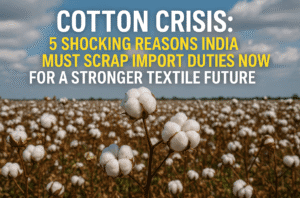Cotton Crisis: 5 Shocking Reasons India Must Scrap Import Duties Now for a Stronger Textile Future
India’s cotton sector faces a critical crossroads as the Committee on Cotton Production and Consumption (COCPC) urges the government to scrap or freeze the 11% import duty to address a widening supply-demand gap. Domestic production is projected to drop to 291.3 lakh bales this season, far below the 315 lakh bales needed by textile mills, forcing reliance on imports that could double to 33 lakh bales. Years of stagnating yields—linked to outdated Bt cotton technology, pest resistance, and climate stress—have eroded India’s once-thriving production edge.
While duty removal would lower costs for mills and signal trade-friendly policies to the U.S., critics warn of risks to farmers if imports suppress local prices. The move underscores a delicate balancing act: easing short-term pressures on industries while revitalizing agriculture through R&D and climate-resilient farming. Success hinges on policies that harmonize immediate trade needs with long-term farm sustainability, ensuring India’s textile competitiveness without sacrificing its agrarian backbone.

Cotton Crisis: 5 Shocking Reasons India Must Scrap Import Duties Now for a Stronger Textile Future
India’s cotton sector, once a global success story, now faces a pivotal moment. With domestic production faltering and demand surging, the Committee on Cotton Production and Consumption (COCPC) has proposed a bold remedy: scrapping the 11% import duty on cotton. This recommendation underscores a critical juncture for farmers, textile mills, and policymakers alike. Here’s a deeper look at the forces driving this decision and its potential ripple effects.
The Production-Demand Mismatch
India’s cotton output for the 2024–25 season is projected to plummet to 291.3 lakh bales (170 kg each), far below the 315 lakh bales needed to meet domestic demand. This deficit—exacerbated by climate shocks, pest infestations, and stagnating yields—has forced mills to rely on imports, expected to double to 33 lakh bales this year. Even with imports, supply (306.83 lakh bales) trails consumption, creating a precarious gap.
The root of the problem lies in agricultural stagnation. Bt cotton, introduced in the early 2000s, initially boosted yields, propelling India to become the world’s top cotton producer. However, no significant genetic advancements have emerged since 2006. Meanwhile, pests like pink bollworm have developed resistance, and erratic weather patterns further strain productivity.
COCPC’s Proposal: A Lifeline for Textiles?
The COCPC’s call to eliminate or freeze import duties aims to ease costs for textile mills, which form the backbone of India’s $170 billion textile industry. An 11% duty reduction could lower input expenses, helping mills remain competitive amid rising global cotton prices. K. Venkatachalam of TASMA notes that failure to act risks squeezing margins, potentially triggering job losses and reduced export competitiveness.
However, the move isn’t without controversy. Critics argue that cheaper imports might depress domestic cotton prices, hurting farmers already grappling with low profitability. Balancing these interests will require nuanced policy—perhaps temporary duty relief paired with long-term agricultural support.
Global Trade Implications
The recommendation carries diplomatic weight. With the U.S. being a major cotton exporter and a key market for Indian textiles, scrapping duties could ease trade tensions. The Trump administration has historically prioritized reducing trade barriers, and this gesture might bolster India’s position in negotiations, particularly for textile exports targeting the U.S. market.
Yet, reliance on imports exposes India to global price volatility. For context, global cotton prices have surged 30% over the past year due to supply chain disruptions and high demand. Strategic stockpiling or futures contracts could mitigate risks, but policymakers must tread carefully.
Beyond Tariffs: Addressing Systemic Issues
While tariff adjustments offer short-term relief, sustainable solutions demand innovation in agriculture. Reviving R&D for pest-resistant cotton varieties, promoting climate-resilient farming practices, and improving seed quality are critical. States like Maharashtra and Gujarat, major cotton hubs, could pilot precision agriculture initiatives to enhance yields.
Additionally, integrating smallholder farmers into digital marketplaces and ensuring fair pricing mechanisms could stabilize domestic supply chains. The Cotton Corporation of India (CCI) might play a larger role in procurement and buffer stock management to shield farmers from import-related price shocks.
The Road Ahead
The COCPC’s proposal reflects a pragmatic response to an urgent crisis. Yet, its success hinges on complementary policies:
- Phased Reforms: Temporarily freezing duties while monitoring farmer impacts.
- Agricultural Revitalization: Investing in biotechnology and sustainable practices.
- Trade Diplomacy: Leveraging duty cuts to strengthen export partnerships.
India’s cotton saga is a microcosm of broader challenges—climate adaptation, globalization, and equitable growth. How the nation navigates this moment could redefine its role in the global textile arena while safeguarding the livelihoods of millions dependent on this “white gold.”
Insightful Takeaway: The cotton duty debate isn’t just about tariffs; it’s a test of India’s ability to harmonize economic pragmatism with agricultural sustainability. Striking this balance will determine whether the sector thrives or merely survives in an increasingly interconnected world.
You must be logged in to post a comment.